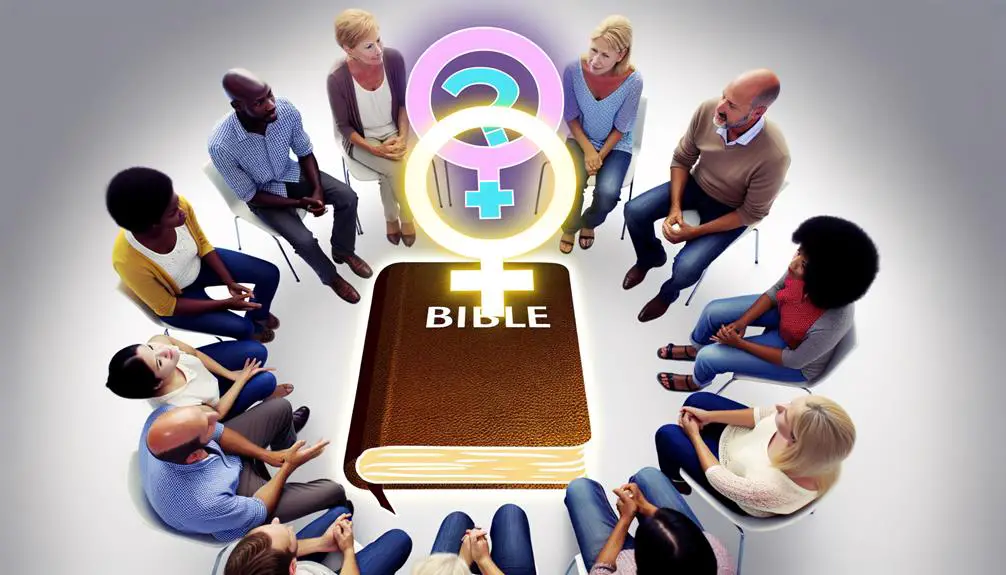Unveil the controversial verses of the Bible that challenge gender equality, sparking debates on interpretation and historical context.

Misogynistic Verses in the Bible
In the realm of spiritual guidance and moral instruction, you find the Bible—a beacon of hope for many, yet within its sacred texts lie verses that starkly contrast with modern views on gender equality. You've likely heard references to women's roles, purity standards, and the concept of submission, raising questions about the historical context and interpretation challenges these passages present.
As you explore this intricate topic, consider how understanding these verses' origins and their evolution over time could offer insights into the ongoing debates around religion and gender equality. Let's embark on a journey to uncover these layers, shall we?
Key Takeaways
- Misogynistic verses reflect ancient societal norms and gender roles, not contemporary values.
- Interpretation challenges arise from language evolution and historical context, affecting understanding.
- Modern perspectives advocate for inclusive interpretations that align with contemporary equality and justice.
- Understanding cultural context is crucial to accurately interpret and address misogynistic verses.
Historical Context

Understanding the historical context of the Bible reveals how its misogynistic verses reflect the societal norms and gender roles of ancient times. The Bible, a compilation of texts from various authors across centuries, is deeply embedded in the historical and cultural milieu of the societies from which it emerged. To grasp why certain verses appear to demean women, it's crucial to examine the archaeological evidence and understand the literary genres that predominate the biblical text.
Archaeological evidence provides tangible insights into the daily lives, beliefs, and societal structures of ancient Near Eastern and Mediterranean societies. These findings illustrate a predominantly patriarchal societal organization, where women's roles were largely confined to the domestic sphere, and their legal and social statuses were significantly inferior to those of men. This societal structure is reflected in the biblical passages that seem to endorse women's subordination.
Furthermore, the Bible comprises various literary genres, including law, history, poetry, wisdom literature, and prophecy. Each genre serves a specific purpose and must be interpreted within its appropriate context. For example, legal texts often mirror the societal norms of the time, aiming to regulate behavior within the given social structure. Poetry and wisdom literature, on the other hand, use metaphor and allegory, which can obscure the original intent when taken at face value.
Interpretation Challenges

You encounter significant interpretation challenges when examining misogynistic verses in the Bible.
The importance of cultural context can't be overstated, as it shapes the understanding of these texts within their historical period.
Moreover, evolving interpretive approaches offer new perspectives, challenging traditional views and inviting a reevaluation of longstanding interpretations.
Cultural Context Importance
To accurately interpret misogynistic verses in the Bible, it's essential to delve into the cultural context within which they were written. Understanding the era's societal norms and language evolution is pivotal.
The Bible's texts were composed in times vastly different from today, with societal norms that shaped perceptions of gender roles. Language evolution also plays a critical role; words and phrases that once had specific meanings can shift dramatically over centuries. This linguistic shift can lead to misinterpretations if the original context isn't considered.
Therefore, to grasp the intended messages behind these verses, you must consider the historical and cultural backdrop, recognizing the influence of societal norms and language evolution on the text's original meaning.
Evolving Interpretive Approaches
Interpreting misogynistic verses in the Bible presents significant challenges due to evolving interpretive approaches that reflect changes in societal attitudes and scholarly methods. These approaches impact how scholars and believers understand gender equality and translation accuracy in biblical texts.
- Historical Context: Recognizing the societal norms when these texts were written.
- Linguistic Nuances: Understanding the original languages to ensure translation accuracy.
- Theological Perspectives: How different denominations view gender equality.
- Feminist Theology: Examining texts from a perspective prioritizing women's experiences and rights.
- Interdisciplinary Methods: Combining insights from sociology, history, and linguistics to enrich interpretation.
These elements underscore the complexity of interpreting biblical verses in a modern context, where gender equality and accurate translation are pivotal.
Verses About Women's Silence

You'll find that assessing the verses related to women's silence in the Bible necessitates understanding their cultural context, a task that's grown complex over centuries.
Modern interpretation challenges arise as scholars and believers alike grapple with reconciling these passages with contemporary values.
Feminist theological responses, moreover, offer critical insights into reimagining these texts for a more inclusive faith practice.
Cultural Context Importance
Understanding the cultural context is crucial when analyzing biblical verses about women's silence, as it sheds light on the historical and societal norms influencing these scriptures. The interpretation of these verses can't be divorced from the gender dynamics and societal norms of the times in which they were written. To fully grasp their meaning, consider these key points:
- Historical period and its view on gender roles
- Prevailing societal norms regarding women's public participation
- Influences of surrounding cultures on biblical texts
- Evolution of language and its impact on current understanding
- The role of religious leaders in interpreting these verses
Modern Interpretation Challenges
While considering the historical and cultural contexts provides insight, interpreting biblical verses about women's silence today presents unique challenges. The main hurdle is navigating the fine line between respecting religious traditions and addressing inherent gender bias.
Many believers adhere to Scriptural literalism, insisting on the exact application of texts, which often places women in subordinate roles. This approach disregards the evolution of societal norms and the growing understanding of gender equality.
Additionally, gender bias in religious interpretations exacerbates the issue, as it influences how these texts are taught and understood, further entrenching patriarchal views. The challenge lies in reevaluating these verses in a way that acknowledges their historical significance while striving for an interpretation that aligns with contemporary values of equality and justice.
Feminist Theological Responses
Feminist theologians have critically engaged with biblical verses about women's silence, advocating for interpretations that champion gender equality without compromising the text's spiritual integrity. They've offered scriptural reimagining that aligns with principles of gender equity, challenging traditional readings that have historically marginalized women.
- Historical Contextualization: Understanding the socio-historical context to avoid anachronistic readings.
- Linguistic Analysis: Examining original language nuances that might suggest alternative interpretations.
- Egalitarian Theology: Proposing frameworks where leadership and voice are equally accessible to all genders.
- Narrative Critique: Highlighting stories of strong biblical women who challenge the silence paradigm.
- Interfaith Dialogue: Comparing interpretations across religious traditions to foster a more inclusive understanding.
These approaches reflect a commitment to re-examining scripture with an eye towards inclusivity and equity, offering fresh perspectives on ancient texts.
Headship and Submission

The concept of headship and submission within biblical texts often sparks intense debate regarding its implications for gender roles and relations. When you delve into the scripture, it's clear that these themes are intertwined with the broader context of authority dynamics and the expected behaviors based on gender. This analysis is crucial for understanding how these principles have historically influenced societal norms.
In the context of headship, the Bible frequently positions men as the leaders within the family and the church. This notion isn't merely about physical or emotional strength but is deeply rooted in the spiritual and moral guidance expected of men. It's a responsibility that carries significant weight, emphasizing the need for wisdom and integrity.
Submission, on the other hand, is often directed towards women, instructing them to yield to their husbands' leadership. This directive can be misinterpreted as a form of oppression; however, a scholarly examination reveals that it's intended to foster a harmonious balance within relationships. It's about mutual respect and the acknowledgment of different roles that complement each other rather than diminish one's value.
These gender roles and authority dynamics have been subjects of reinterpretation in modern times. The discussion isn't about questioning the validity of the scriptures but understanding their application in a contemporary context. By analyzing these texts with a critical eye, you're able to discern the difference between cultural norms of the past and the timeless spiritual principles meant to guide behavior and relationships.
Purity and Virginity Standards

Shifting our focus, we now examine how biblical texts articulate standards of purity and virginity, revealing their profound impact on gender roles and societal expectations. The emphasis on virginity, particularly for women, not only informs marital expectations but also delineates societal roles, reflecting a broader perspective on women's value and autonomy within the biblical context.
The biblical portrayal of purity and virginity standards contributes significantly to the construction of gender identity and the expectation of women's behavior before marriage. These standards aren't merely religious or spiritual guidelines but are deeply intertwined with the social fabric, influencing perceptions and treatment of women across various contexts.
- Virginity as a prerequisite for marriage: This establishes a woman's worth in relation to her marital eligibility.
- Purity laws emphasizing female chastity: These laws disproportionately focus on women, affecting their freedom and societal status.
- Ritual purification: This suggests a gendered dimension to spiritual cleanliness, often placing a heavier burden on women.
- Consequences for non-compliance: The harsh repercussions for women failing to meet these standards underscore the societal importance placed on virginity.
- Impact on marital negotiations: Virginity and purity standards play a crucial role in marital arrangements, affecting women's agency in choosing a partner.
Analyzing these aspects, it's clear that biblical purity and virginity standards have historically shaped and reinforced gender roles, particularly disadvantaging women by placing undue emphasis on their sexual conduct. These standards have perpetuated a framework within which women's value and societal roles are closely tied to their sexual purity, influencing marital expectations and their position within society.
Women as Property

Throughout history, biblical texts have often depicted women as property, fundamentally affecting their societal and familial roles. This representation hasn't only influenced the treatment of women within these contexts but has also been a cornerstone in the development of societal norms that dictate a woman's place and value. You'll find that the Bible, particularly in the Old Testament, contains laws and narratives that might seem to reduce women to mere possessions, exchangeable and subject to the authority of male relatives.
This perception, deeply ingrained in ancient societies, has seen challenges and legal reforms over centuries, aiming to redefine women's roles beyond property and towards individuals with rights and agency. However, the historical context of these scriptures reflects the times they were written in, where patriarchy dominated, and women's rights were significantly limited.
Legal reforms have gradually shifted this perception, though the process is ongoing and fraught with challenges. These reforms often clash with traditional interpretations of religious texts, leading to debates about the balance between adhering to faith and advancing gender equality. Societal norms, too, are evolving, albeit slowly, influenced by both legal changes and growing awareness of gender issues.
The transition from viewing women as property to recognizing them as equal partners requires a re-examination of these texts and the contexts in which they were written. It's a testament to the dynamic nature of societal values, which can evolve beyond the constraints of historical interpretations. This evolution, while complex, is crucial for the development of more inclusive and equitable societies.
Punishments and Inequalities

Building on the exploration of women's roles as property, it's crucial to examine the related biblical punishments and inequalities that further underscore the gender disparities within these texts. These disparities often reflect and reinforce societal norms and expectations regarding gender roles, painting a complex picture of the historical context in which these texts were written.
The analysis reveals a variety of punishments and inequalities, such as:
- Differential adultery punishments, where women often face harsher consequences than men, highlighting a double standard in sexual morality.
- Laws concerning divorce and remarriage, which disproportionately disadvantage women, limiting their rights and freedoms in comparison to men.
- Ritual impurity laws, which treat women's natural biological processes as sources of impurity, imposing restrictions that underscore gender-based segregation and inequality.
- Inheritance laws, where sons are favored over daughters, reflecting and reinforcing the patriarchal structure of society and the marginalization of women.
- Testimonial restrictions, where women's testimonies are either not permitted or valued less than men's, undermining women's agency and credibility in legal and societal contexts.
These examples illustrate how biblical texts can perpetuate gender inequalities, shaping and being shaped by the societal norms of their time. It's important to approach these texts with a critical eye, acknowledging their historical and cultural context while engaging in discussions about their contemporary implications and interpretations. This analysis not only sheds light on the treatment of women in ancient texts but also invites reflection on the ongoing impact of these narratives on modern understandings of gender roles and equality.
Modern Perspectives and Debates

In contemporary discussions, debates over the relevance and interpretation of misogynistic verses in the Bible are pivotal in understanding evolving views on gender equality. You find yourself in the midst of a transformative era where the quest for gender equality intersects with religious beliefs, sparking intense debates and calls for religious reform.
The heart of the matter lies in how you interpret these verses today. Do they reflect outdated norms or are they timeless principles? This question fuels the modern scholarly and theological debates. The push for a re-examination of these texts advocates for an interpretation that aligns with contemporary values of gender equality. You're witnessing a shift towards inclusive interpretations that seek to reconcile faith with the principles of equality and justice.
Emotion Evoked |
Reason |
|---|---|
Hope |
The possibility of religious reform that aligns with gender equality ignites hope for a more inclusive and fair interpretation of religious texts. |
Frustration |
The slow pace of change and the resistance faced by advocates for reform can evoke feelings of frustration among supporters of gender equality. |
Empathy |
Understanding the historical context of these verses can foster empathy towards those struggling to reconcile their faith with modern values. |
Resolve |
The ongoing debates and the efforts of reformers strengthen the resolve to challenge and change misogynistic interpretations. |
The synthesis of modern perspectives into the interpretation of biblical texts is not just an academic exercise; it's a reflection of society's evolving views on gender and equality. As you engage with these debates, you're contributing to a broader discourse on how religious teachings can adapt to uphold the principles of gender equality and foster an environment of inclusivity and respect.
Frequently Asked Questions
How Have Feminist Theologians Approached and Reinterpreted Misogynistic Verses in the Bible to Align With Contemporary Feminist Values?
You've seen feminist theologians tackle challenging texts through scriptural reinterpretation, aiming for gender reformation within religious narratives. They delve into historical and cultural contexts, suggesting these verses reflect their times, not timeless mandates.
In What Ways Have Non-Christian Religions and Their Scriptures Addressed Similar Themes of Misogyny, and How Do These Approaches Compare to Those Found in the Bible?
In exploring non-Christian religions, you'll find Islamic feminism and Hindu patriarchy also grappling with themes of misogyny.
Just as feminist theologians reinterpret biblical verses, Islamic feminists challenge traditional interpretations of the Quran, promoting gender equality.
Similarly, against Hindu patriarchy, activists and scholars seek to reclaim texts, highlighting empowering narratives.
These approaches mirror and diverge from Christian strategies, offering a rich tapestry of religious responses to misogyny across different faiths.
How Do Different Christian Denominations Today Actively Work to Address and Amend the Church Practices That Have Been Influenced by These Misogynistic Verses?
Different Christian denominations are actively working to address and amend church practices by focusing on inclusive church leadership and progressive scriptural interpretation.
You'll find they're engaging in open dialogues, reevaluating traditional roles, and promoting gender equality within their communities.
This approach involves critical analysis and reinterpretation of scriptures, aiming to align church practices with contemporary understandings of gender equality, ensuring that leadership and opportunities within the church are accessible to everyone, regardless of gender.
What Psychological and Societal Impacts Do These Misogynistic Biblical Verses Have on Young Women and Girls in Religious Communities Today?
You're navigating a complex landscape where cultural traditions and gender identity intersect, casting long shadows on young women and girls in religious communities. These verses, deeply rooted in historical texts, shape societal norms and individual self-perception.
Analytically speaking, they contribute to a skewed gender identity, reinforcing stereotypes and limiting potential. Their impact is multifaceted, affecting psychological well-being and embedding restrictive roles within cultural traditions, challenging progress toward gender equality.
Are There Any Documented Instances Where Biblical Verses Perceived as Misogynistic Were Actually Mistranslated or Misunderstood Due to the Evolution of Language Over Centuries?
You're delving into whether some biblical verses have been misinterpreted due to linguistic evolution and shifts in cultural context. It's true, over centuries, language changes and the original meanings can become obscured or altered. Scholars have documented instances where this has occurred, leading to misunderstandings of the text's intent.
Analyzing these verses with a focus on their historical and cultural backdrop offers a clearer, more objective understanding of their original significance.
Conclusion
In reflecting on the discussed misogynistic verses within the Bible, it's crucial to recognize the evolving interpretation and context.
A 2018 survey found that 62% of women feel that traditional religious texts contribute to their societal undervaluation. This statistic highlights the emotional and societal impact of scriptural interpretations.
Therefore, engaging in scholarly, critical examinations and fostering inclusive dialogues are essential steps toward understanding and potentially mitigating the adverse effects of these historical perspectives on modern gender relations.



Sign up